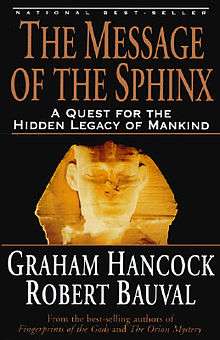The Message of the Sphinx
 | |
| Language | English |
|---|---|
| Subject | The Great Sphinx of Egypt |
| Publisher | Crown Publishers |
Publication date | 1996 |
| ISBN | 9780614968170 |
| OCLC | 34887732 |
The Message of the Sphinx: A Quest for the Hidden Legacy of Mankind (Keeper of Genesis in the United Kingdom) is a book written by Graham Hancock and Robert Bauval in 1996 which argues that the creation of the Sphinx and Pyramids occurred as far back as 10,500 BC using astronomical data.
Overview
Working from the premise that the Giza complex encodes a message, the book begins with recently discovered geological evidence that the authors believe suggests that that the deep erosion patterns on the flanks of the Sphinx were caused by 1000 years of heavy rain. The authors go on to suggest, using computer simulations of the sky, that the pyramids, representing the three stars of Orion's Belt, along with associated causeways and alignments, constitute a record in stone of the celestial array at the vernal equinox in 10,500 BC. This moment, they contend, represents Zep Tepi, the "First Time," often referred to in the hieroglyphic record. They state that the initiation rituals of the Egyptian pharaohs replicate on Earth the sun's journey through the stars in this remote era, and they suggest that the "Hall of Records" of a lost civilization may be located by treating the Giza Plateau as a template of these same ancient skies.[1]
References
- ↑ Hancock, Graham; Bauval, Robert (1996). The Message of the Sphinx: A Quest for the Hidden Legacy of Mankind. New York: Crown Publishers. ISBN 9780614968170. OCLC 34887732.